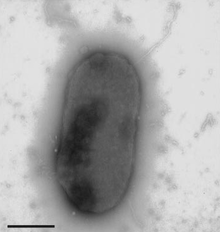Alishewanella fetalis
| Alishewanella fetalis | |
|---|---|
 | |
| A. fetalis grown on a BHI agar plate visualized by transmission electron microscopy | |
| Scientific classification | |
| Domain: | Bacteria |
| Phylum: | Proteobacteria |
| Class: | Gammaproteobacteria |
| Order: | Alteromonadales |
| Family: | Alteromonadaceae |
| Genus: | Alishewanella |
| Species: | fetalis |
The genus Alishewanella is one of the major branches of the family Alteromonadaceae. It was proposed to accommodate A. fetalis, isolated from an autopsy of a human fetus, in 2000.[1] In 2009, A. aestuarii was isolated from tidal flat sediment and indicated as being a representative of Alishewanella.[2] The third Alishewanella species was isolated from gajami sikhae, a Korean fermented food, in 2009 and was given the name A. jeotgali.[1] Most recently, in 2010, the fourth currently isolated species of Alishewanella, A. agri, was isolated from landfill soil in Korea.[3] Currently these are the only four isolated and characterized species of the genus Alishewanella.
Identification
Alishewanella fetalis is a Gram-negative, non-motile, facultatively anaerobic, rod-shaped bacterium. These rods are about 2 μm in length and 0.5-1 μm in width. They typically occur as a single cell.[4] It was initially mislabelled as Shewanella putrefaciens, previously known as Pseudomonas putrefaciens, due to the presence of similar fatty acids[4] in its membrane lipids. However, after further evaluation, it was found that this was a novel species. Due to the relatedness to Shewanella, the genus was named Alishewanella. Also, having been initially isolated from an autopsy of a human fetus in 1992 in Sweden, it was given the species name fetalis.[4]
Growth
A. fetalis grows at temperatures between 25° and 42°C, with optimum growth at 37°C. It cannot grow below 20°C.[4] It is facultatively anaerobic and can utilize electron acceptors such as trimethylamine oxide (TMAO), nitrate, nitrite, and thiosulphate, but not sulphite or ferric iron.[5] It is not only halotolerant, but requires NaCl for growth. NaCl concentrations of up to 8%, but not 10% are tolerated.[4] A. fetalis is oxidase- and catalase-positive but does not produce indole and β-galactosidase. It cannot ferment carbohydrates.[4] By these results, A. fetalis is very closely related to both Shewanella putrefaciens and Shewanella algae.[4] However, A. fetalis differs from the Shewanella genus by the ability to produce H2S.[4]
Genome
Studies of A. fetalis show that the GC content of the genome is 50.6%,[5] which differs greatly from that of Shewanella putrefaciens, with a GC content of 42-47%.[4] It shows a relationship to both Rheinheimara baltica through 16S rRNA,[5] and to the family Vibrionaceae through gyrase B.[4] With regards to other Alishewanella species, A. fetalis is closely related to Alishewanella jeotgali (98.04%),[1] Alishewanella aestuarii (98.3%),[2] and Alishewanella agri (98.7%)[3] by 16S rRNA.
References
- 1 2 3 Min-Soo Kim; Seong Woon Roh; Young-Do Nam; Ho-Won Chang; Kyoung-Ho Kim; Mi-Ja Jung; Jung-Hye Choi; Eun-Jin Park; Jin-Woo Bae (2009). "Alishewanella jeotgali sp. nov., isolated from traditional fermented food, and emended description of the genus Alishewanella". 59. International Journal of Systematic and Evolutionary Microbiology: 2313–2316. doi:10.1099/ijs.0.007260-0. Retrieved November 19, 2012.
- 1 2 Seong Woon Roh; Young-Do Nam; Ho-Won Chang; Kyoung-Ho Kim; Min-Soo Kim; Hee-Mock Oh; Jin-Woo Bae (2009). "Alishewanella aestuarii sp. nov., isolated from tidal flat sediment, and emended description of the genus Alishewanella" (PDF). 59. International Journal of Systematic and Evolutionary Microbiology: 421–424. doi:10.1099/ijs.0.65643-0. Retrieved November 26, 2012.
- 1 2 Min-Soo Kim; Seon Kyung Jo; Seong Woon Roh; Jin-Woo Bae (2010). "Alishewanella agri sp. nov., isolated from landfill soil" (PDF). 60. International Journal of Systematic and Evolutionary Microbiology. pp. 2199–2203. Retrieved November 26, 2012.
- 1 2 3 4 5 6 7 8 9 10 Birte Fonnesbech Vogel; Kasthuri Venkateswaran; Henrik Christensen; Enevold Falsen; Gunna Christiansen; Lone Gram (2000). "Polyphasic taxonomic approach in the description of Alishewanella fetalis gen. nov., sp. nov., isolated from a human foetus" (PDF). International Journal of Systematic and Evolutionary Microbiology. 50: 1133–1142. doi:10.1099/00207713-50-3-1133.
- 1 2 3 Brettar, Ingrid; Christen, Richard; Höfle, Manfred (2002). "Rheinheimera baltica gen. nov., sp. nov., a blue-coloured bacterium isolated from the central Baltic Sea". International Journal of Systematic and Evolutionary Microbiology. 52: 1851–1857. doi:10.1099/ijs.0.02151-0.